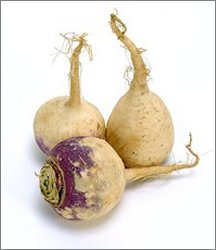The Turnip: Nutrition, Uses and Some Interesting Lore of "One of the Most Important Vegetables"
by www.SixWise.com
Turnips have been enjoyed since ancient times, when they
were cultivated nearly 4,000 years ago in the Near East. This
round, apple-sized vegetable was prized by the Greeks and
the Romans, and was even called one of the most important
vegetables of the time by ancient author Pliny the Elder.
|

Turnips were first known as "neeps," which
came from the Latin word for turnip "napus.
|
Throughout the centuries, turnips have been:
-
Wrapped in wild onions and leaves, then roasted over
a fire
-
Mashed along with potatoes and served with butter
-
Used instead of cabbage to make coleslaw and sauerkraut
-
Used instead of pumpkins to make jack o' lanterns
The Cancer-Fighting, and Other Beneficial, Reasons to
Eat Turnips
Turnips are a member of the cruciferous
family of vegetables, along with broccoli, cauliflower,
Brussels sprouts, cabbage, collard greens and more.
These veggies include a dozen or more health-promoting compounds
that can fight cancer and other illnesses. Among them:
-
Indole-3-carbinol: A glucosinolate that's formed when
the vegetables are crushed or cooked. Research has found
that it deactivates an estrogen metabolite that promotes
tumor growth, particularly in breast cells. It's also
been found to keep cancer cells from spreading to other
parts of the body.
-
Crambene: A phytonutrient.
- Sulforaphane: A type of isothiocyanate that's been found
to increase the liver's ability to detoxify carcinogenic
compounds and free radicals. This in turn protects against
cell mutations, cancer and other harmful effects.
Turnips also contain more familiar nutrients such as fiber,
vitamin C, vitamin B6, folate, calcium, potassium and copper.
|

Adding turnips to your regular mashed potatoes is an
easy way to get more cancer-fighting nutrients in your
diet.
|
When it comes to turnips, most people focus on the root,
but the greens of this plant are also incredibly healthy (and
have a pleasant, slightly bitter flavor). Turnip greens help:
-
Provide relief from rheumatoid arthritis
-
Promote colon health (including lowering the risk of
colon cancer) Fight against atherosclerosis
-
Promote lung health
-
Fight against declines in mental function
How to Enjoy Turnips
Turnips have been unfairly singled out as an unpleasant vegetable,
when in reality their taste is similar to radishes when raw,
and very mild once cooked.
You can use turnip roots anytime you would use a potato,
and then some. Try them mashed, baked, boiled, in stews, soups
and stir-fries, or lightly steamed with some butter, salt
or lemon juice for flavor.
You will often find turnips sold with their greens attached,
so take advantage of them! Turnip greens are delicious sautéed
or steamed as a side dish with garlic, onion, olive oil and
lemon, or as an addition to soups, stews and pasta.
If you're looking for a slightly more creative way to try
out turnips, try out the hearty, warming casserole side-dish
below.
Crunchy Turnip Crumble
Ingredients:
1 large or 2 medium turnips
3 tablespoons
1 tablespoon spoon brown sugar
2 medium eggs
1 teaspoon baking powder
1/2 teaspoon salt
1/2 teaspoon white pepper
pinch of freshly grated nutmeg
For the topping:
8 tablespoons of breadcrumbs
2 tablespoons melted butter
Method:
- Cook and mash cubed turnip with 2 tablespoons of butter.
- Add mixed dry ingredients to mashed turnip, along with
2 eggs, well beaten.
- Put turnip mixture into casserole dish. Sprinkle with
topping and bake for 25 minutes in a medium oven or until
light brown on top.
Recipe source: Mr.
Neep
Recommended Reading
14
Fruits and Vegetables That Provide the Best Protection Against
Arthritis
Potatoes:
Once and For All, Are America's Favorite Vegetables Good for
You or Not?
Sources
Sally's
Place
The
World's Healthiest Foods